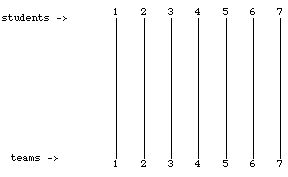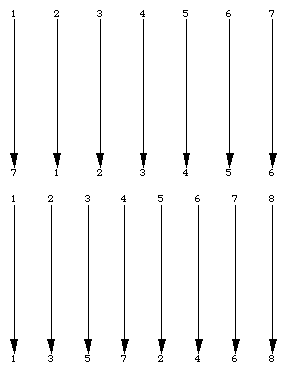Teaching Notes for the Amida-kuji Problem
Day 1
Make sure that everyone understands the process. Here is a way to group students in your class to work cooperatively and review amida-kuji at the same time. This is easiest to describe if you have a composite number of students like 21, but you can adjust it to work for other numbers without much trouble. Let's suppose that you want your 21 students to work in teams of 3 on this project. Arrange the students in groups of  students per group. For each group have them set up an amida-kuji like this.
students per group. For each group have them set up an amida-kuji like this.

Have each table fill in some horizontal lines and each students' path will determine which team to join. Using this method, each group will assign one student to each research team and you'll have seven groups of three to continue the lesson.
Have the teams sit together for the rest of the day to work on the warm-up problems.
Day 2
In Days 2 and 3, use the same teams as were formed in Day 1. Review results of the warm-up problems and see if anyone has any further observations. Challenge the teams to find ways to make the following assignments.

Let teams challenge other teams to solve similar problems with the fewest number of horizontal lines.
Encourage the teams to come up with a system for solving these problems.
Day 3
Allow students time to give updates on their progress toward answering the original questions.
Talk about extensions to the problem. For example, explain the connection with sorting networks.